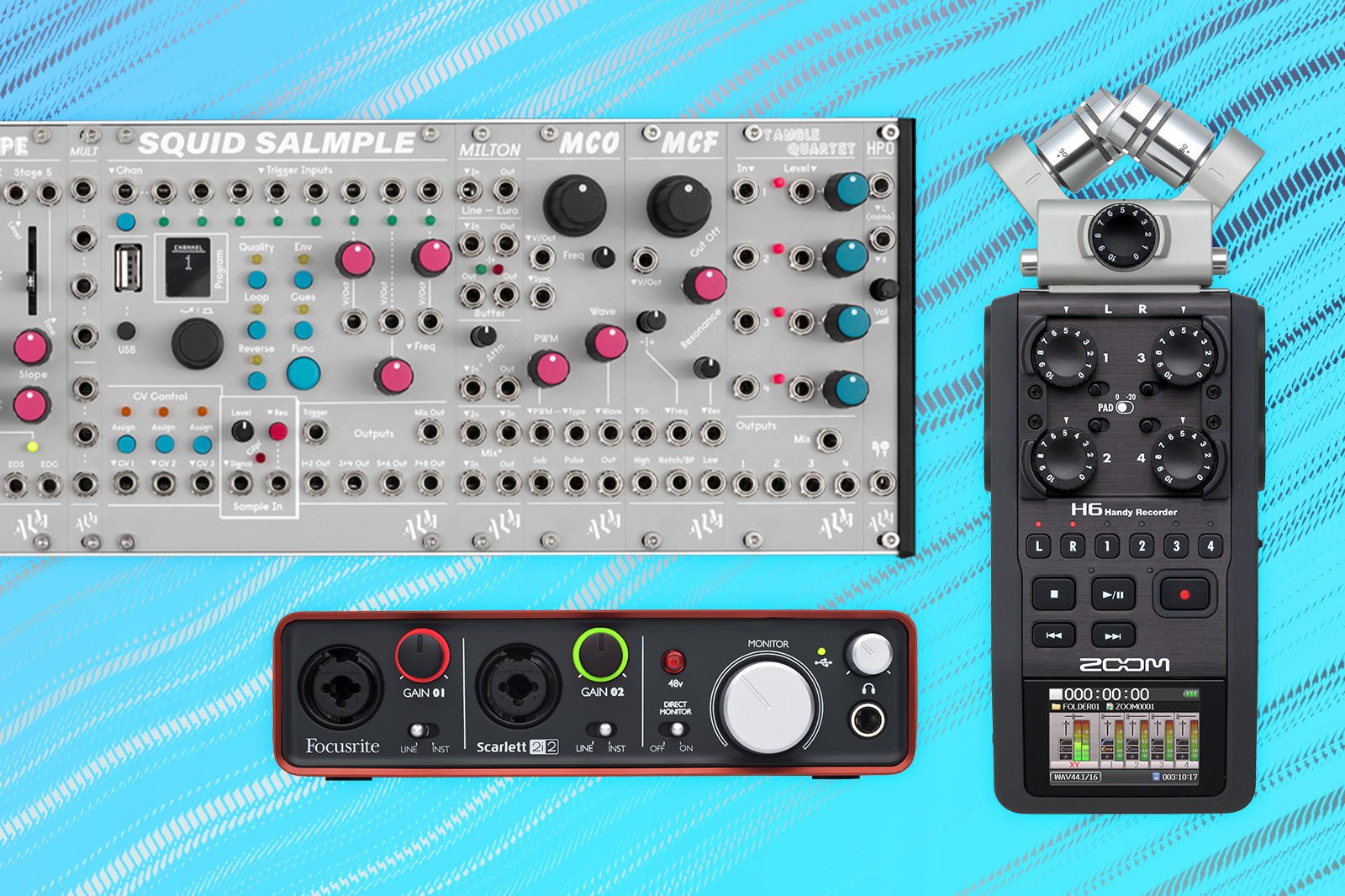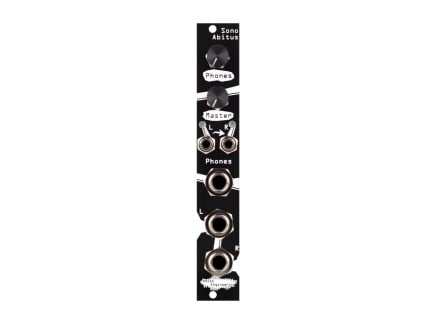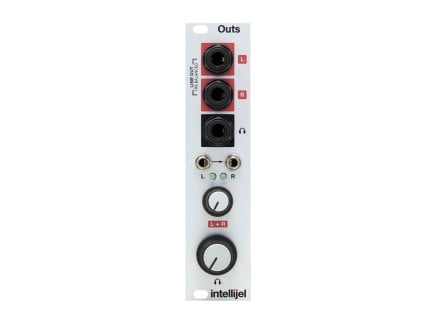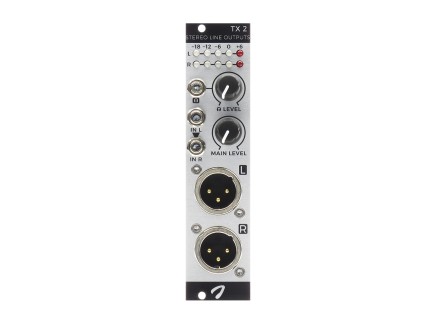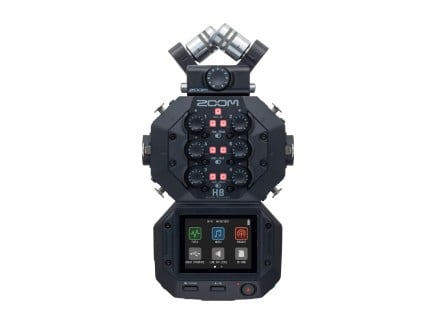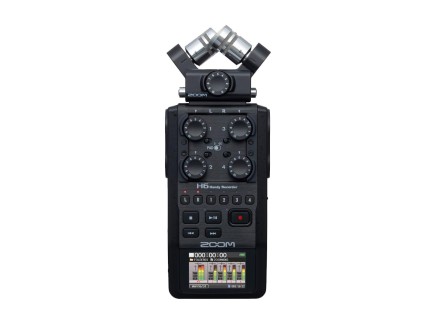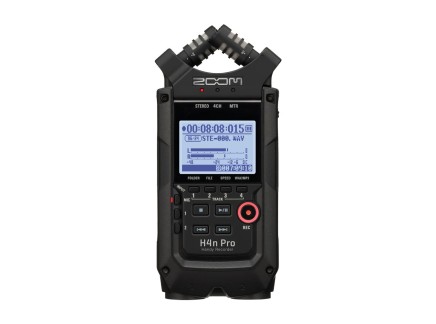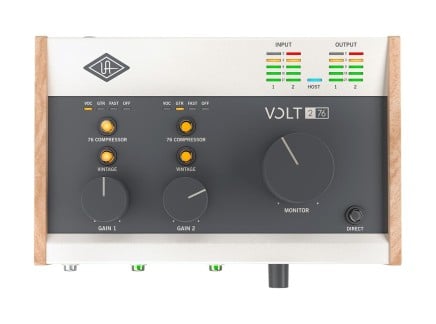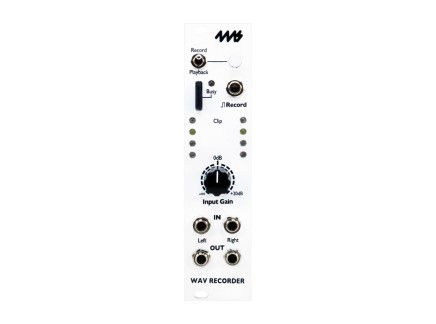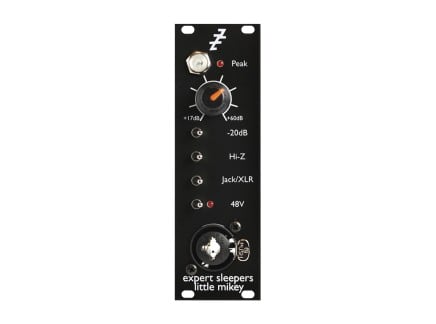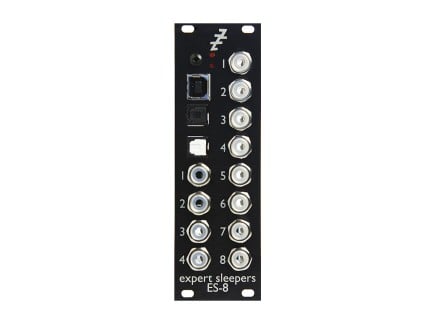Here on Signal, we often talk about modular synths—our favorite modules, how to use them, how to pair different gear together in different ways—but there's another part of the musical process we don't always discuss in depth: recording.
We recognize that for many folks, modular synths are their first foray into music-making altogether. In many ways, that's fantastic; after all, modular synths offer a lot of musical immediacy and opportunity even without extensive musical training (an idea which I discussed in greater depth in our recent article What is a Modular Synthesizer?). But modular synths can still have a bit of a learning curve...and over the years, we've noticed that even though many folks get into modular synths with an initial goal of making and sharing their music, a couple of things often get in the way of committing their sounds to recordings.
Part of this, we suspect, is about a general avoidance of the computer: many folks get into modular synths as a way of getting away from their computer when making music. We also suspect that part of this is about folks not wanting to overload themselves with new information—after all, learning to use a modular synth already requires a fair amount of focus on technical details, and if you're not already familiar with recording, then that can start to feel like its own mysterious and deep rabbit hole of technical jargon and qualitative questions. What audio interface should I get? Do I need a mixer to start recording? What's the best field recorder out there?
Luckily, these questions aren't as complicated as they might first seem. In this article, we're going to take a closer look at these concerns and different ways to approach them. We'll talk about some simple technical considerations for recording your modular synth, and then we'll discuss some pros and cons of recording onto a computer versus recording onto a field recorder. So if you're ready to get started recording your modular system, let's dive in!
Technical Considerations: Signal Levels
As with many aspects of playing modular synth, the first thing we need to consider are signal levels. We've talked about this in several other articles, including this one specifically about interfacing audio gear that uses different signal levels. In short, modular signals have a considerably higher voltage range than is typically expected by pro audio gear, so you may need to exercise some caution when interconnecting your synth with recording equipment. This is generally true regardless your preferred recording method—so whether you're recording onto a computer via an audio interface or onto a field recorder, this is something you'll want to keep in mind.
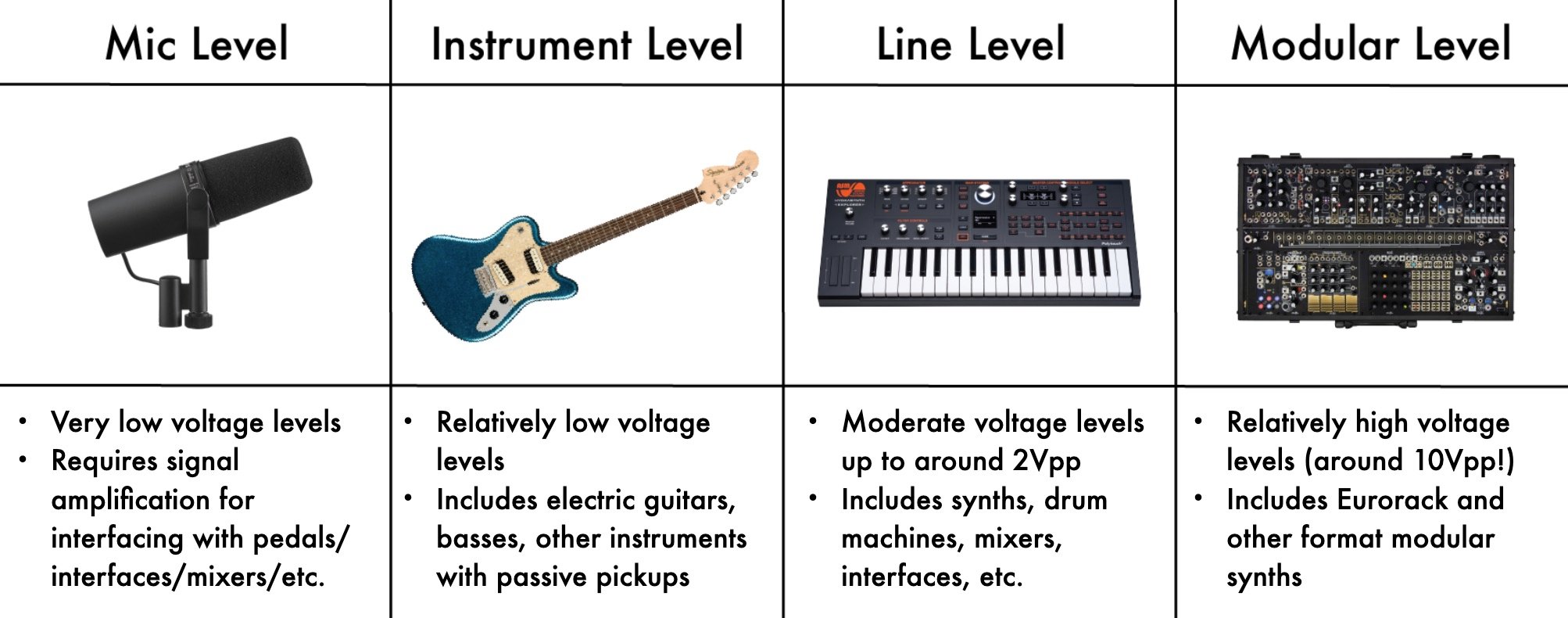
Generally speaking, most music gear produces and expects signal levels that fall into four general ranges: mic level, instrument level, line level, and modular level. As you might expect, microphones produce mic level signals. Devices with instrument level outputs include electric guitars or other devices with passive pickups. Line level gear includes things like keyboards, drum machines, mixers, audio interfaces, and other pro audio gear—this sort of gear usually produces and accepts signals up to around 2Vpp. Eurorack synthesizers, on the other hand, have considerably higher output voltage ranges—commonly up to around 10Vpp.
When you go to record your modular system, this is an important thing to keep in mind. Most recording equipment—be it mixers, audio interfaces, and field recorders—is optimized to receive signals from mic, instrument, and line level devices, but most Eurorack modules' outputs are much hotter than this. As such, it's usually a good idea to attenuate your outputs to a signal level that is more suitable for use with pro audio gear.
Technically, you can do this using any attenuation method—you could simply scale down your output levels using attenuators or VCAs, and then use a 3.5mm–1/4" TS cable to plug out into your recorder/interface/what-have-you. However, in order to get things into the right signal level "ballpark," to allow for finer level adjustments, and to take advantage of recording gear's typical use of balanced inputs for minimizing noise/irregularities in your audio, we typically recommend using a dedicated output interface module in order to connect your Eurorack system to external pro audio gear.
Output modules don't need to be complex or expensive, of course! Some personal favorites include Intellijel's Outs, Befaco's Output V3, Noise Engineering's Sono Abitus, and Joranalogue's Transmit 2 (of which I have two in my personal system). Each of these has slightly different feature sets/form factors—but the big takeaway is that all of them act as both balanced stereo line-level output modules (with additional headphone outputs), making it straightforward to get a stereo output (or two mono outputs) from your modular and into your recording equipment.
Technical Considerations: Multitracking
When plotting out how best to set up your system for recording, though, there's another workflow consideration to keep in mind—would you prefer to set up your system to multitrack?
Audio recording can be done in a couple of ways, each with their respective advantages and disadvantages. One common approach is to record a stereo master of your entire mix. This is by far the simplest approach—if you're already accustomed to mixing together distinct voices in your synthesizer and directing them all collectively to a headphone output or a couple of speakers, then it's relatively straightforward to do this sort of recording, simply capturing the same mix that you hear in real time. The alternative to this approach is multitracking, where instead of recording your full mix into a single audio file, you instead record individual voices or groups of voices into separate audio files.
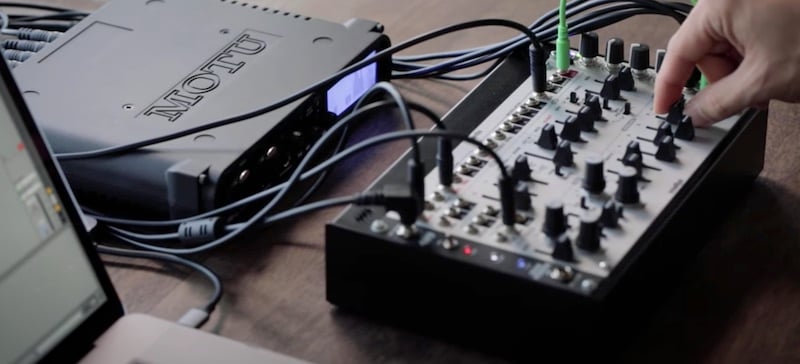
Multitracking has distinct advantages—largely centered around the ease of editing/mixing that it affords. By maintaining separation between individual sounds when recording, it becomes easier (for me, at least!) to focus on my performance rather than worrying about how making bold performance decisions in the moment might affect the quality of my recording. If something accidentally gets too loud, or something gets knocked into a frequency range where it's competing with other sounds, for instance, I have the safety net of knowing that I can still tweak each sound completely independently when I get to the stage of mixing without affecting all the other sounds. Moreover, this enables far more options for creative mixing/editing decisions down the line: if each of your sounds is tracked independently of the others, then you can change the shape of your mix entirely, creatively resample individual sounds, and much more. So if the editing/mixing process feels like an inspiring and exciting place for you to exercise your creativity, then multi-tracking your performances/soundmaking sessions can open up loads of options for you down the line.
Of course, editing/mixing doesn't have to be the place where you spend the bulk of your creative energy! For many modular musicians, simply recording a master mix of their entire patch can be an effective way of avoiding decision paralysis down the road—and if you've got a good-sounding mix that you're happy with as it is happening and don't necessarily plan on doing additional tweaks/edits down the line, then there's absolutely nothing wrong with recording a full mix as it is.
Either way, the specific workflow decision you make in this regard (multitracking vs. recording full stereo mixes) will have an effect on the gear you'll need to really optimize your recording workflow. The number of independent tracks you can simultaneously record is determined by the hardware that you're using to record (your interface or recorder). We'll talk about this more below, so don't fret.
Of course, the number of tracks you can record at once is also partly determined by the number of outputs you can simultaneously send from your modular system. That's the reason, as I mentioned before, that I have two Joranalogue Transmit 2 modules in my system: personally, I often find myself recording two stereo sources at a time, or as many as four mono sources, and having two stereo output modules makes it easy to get those signals out of my modular system and into my audio interface at a relatively consistent signal level. Occasionally, I do still find that I want to send more than four independent voices out of my system—and in those situations, I start to prioritize how to route things based on the amount of independence I think I'll ultimately need between these different voices. For instance, if I have four percussive voices that collectively make up a "rhythm section" of sorts, I might go ahead and mix them together in the modular in order to make "room" to multitrack other sounds that require greater independence. There aren't any rules in this process—and, like many things in life, it's a matter of balancing practicality with flexibility. There will almost always be limits to the number of independent tracks you can record...so if you're going the route of multi-tracking, developing a sense of how and when to group different items will likely prove valuable at some point in your music-making journey.
Understanding Field Recorders
Field recorders and audio interfaces are both hugely valuable, yet quite different tools for recording. Each can be of use to modular synthesists, so let's briefly outline what each one is designed to do.
Field recorders are portable recording devices designed to allow you to capture sound anywhere you might be. These days, field recorders often feature built-in microphones and some number of analog inputs that allow direct connection from external microphones or other gear. The number and format of these inputs can vary considerably—they may be simple 3.5mm stereo line inputs, mic inputs, or 1/4" line inputs. Often, field recorders store their recordings onto a removable SD or microSD card, which can later be removed in order to transfer files onto a computer. Portable field recorders also usually have a dedicated headphone output so that you can more easily monitor what you’re recording in real time.
Some of the most important distinctions between such recorders for the purpose of this discussion has to do with the number of simultaneous inputs they have. Remember—if you're just aiming to record a stereo mix from your modular system onto a field recorder, you only need two simultaneous external inputs. If you're multitracking, though, you may benefit from a recorder with more inputs.
Take Zoom's series of "handy recorders," for example. The H4n, for instance, includes a stereo pair of built-in microphones and a pair of XLR/TRS combo inputs that can connect to external mics or line-level gear. The H6, on the other hand, features four dedicated external inputs, each of which can be used in conjunction with microphones or line level gear. It also offers an exchangeable capsule, which can be used to connect a variety stereo microphone capsules, or a specialized capsule (the EXH-6) that provides access to another two external mic/line inputs. The H8 adds yet another two inputs and maintains the exchangeable capsule feature of the H6—meaning that you could hypothetically use it to track eight individual sound sources at a single time. Whoa.
Understanding Audio Interfaces
So if field recorders can do so much...what's up with audio interfaces?
Audio interfaces are devices designed to help you record sound onto a computer—but they do not have the capacity to store sounds internally. Instead, they're more like a gateway between your DAW/recording software and the external world. Like field recorders, audio interfaces may have any number of inputs. Unlike field recorders, audio interfaces also usually have a more fully-featured section dedicated to outputs, making it possible to send sound out from your computer to the external world...either to run to monitors, or to be processed through external effects and then re-recorded. Because live performance with DAWs has become so common, it's relatively easy to find rugged/portable audio interfaces, of course—but unlike field recorders, they are dependent on a computer (or tablet/phone, where applicable) in order to actually record.
Audio interfaces can range considerably in price—from ~$100 entry-level devices to professional, studio-grade gear in the thousands of dollars. Earlier this year, I published an article about how to choose your first audio interface which goes into this topic in greater detail, but for the moment, let's look at some of our favorite affordable interface lines to give you a sense of what's out there.
Focusrite's Scarlett range of USB audio interfaces are a long-standing line of affordable, rugged, and reliable designs that bring as much value to beginners as possible. The current generation of Scarlett interfaces range from the dual-input Scarlett Solo (one mic, one instrument/line input) and Scarlett 2i2 (two mic/line/instrument inputs) all the way to the eight-input (two mic/line/instrument, six mic/line) Scarlett 18i20. If you're just getting started with recording, these are an excellent value. A particular personal favorite is the Scarlett 4i4, which provides four simultaneous inputs (two mic/line/instrument, two line) and four line outputs—a great balance for a wide variety of recording, reamping, and live performance situations.
Coincidentally—as of the time of publishing this article, all newly-registered Scarlett interfaces include Focusrite's "Hitmaker" expansion bundle, which includes Ableton's Live Lite and a 3-month subuscription to Avid's Pro Tools, as well as a wide variety of endlessly useful plugins from Antares, Softube, XLN Audio, and much more. If you're brand new to things and looking for your first DAW and a selection of useful virtual instruments or processing tools, this is an incredible value.
Universal Audio's new VOLT line of interfaces represents a similar balance of features to cost, with a strong emphasis placed on overall sound quality. With their years of experience producing high-quality preamps, converters, and processors in the form of their Apollo interfaces, Universal Audio can certainly be trusted to create no-nonsense, reliable pro audio gear. The VOLT line is no exception—stripping back the DSP capabilities of the Apollo series and providing an excellent-sounding set of preamps and converters sure to help any sound source sound its best.
Presently, the line includes five interfaces: the VOLT 1, VOLT 2, VOLT 176, VOLT 276, and VOLT 476. Our top pick among these is the VOLT 476—which offers two mic/line/instrument inputs and two additional line inputs. The two mic/line/instrument channels feature preamps with dedicated switches for "vintage" or "modern" operation as well as switchable 1176-style compression—but even without engaging these features at all, the sound quality is absolutely superb. This model also features two main monitor outputs, headphone output, and four additional assignable line outputs, great for general-purpose signal routing in your home studio setup.
Of course, there are plenty of other useful interfaces out there—companies like Antelope Audio, SSL, MOTU, Steinberg, and others all produce high-quality interfaces at reasonable prices. We hope though, that these examples have given you a sense of what audio interfaces can be like, and how they might fit into your setup.
Do I Need a Field Recorder? Or an Audio Interface?
That brings us to an obvious question: which makes more sense for you, a field recorder or an audio interface?
A field recorder might make sense if you're trying to do on-site recordings away from a computer—recording live gigs, and the like. For many, that could be as simple as recording the stereo output from your system; but of course, multitracking is still a possibility in that scenario. And of course, if you're intentionally avoiding the use of a DAW for editing/mixing down the line, then a field recorder feels like an obvious choice. If you're hoping to use a DAW for editing/mixing, then either a multi-track field recorder or an audio interface could work fine for you (in fact, many field recorders can even double as audio interfaces, directly sending audio into your DAW when connected via USB). An audio interface, of course, will provide you considerably more robust output options—and at the end of the day, if a DAW/studio workflow is part of your creative practice, having a dedicated audio interface is going to make your life much simpler.
In real life? I'd recommend having both. Personally, I keep my studio setup fully connected to my primary instruments, monitors, etc. I generally take field recorders with me to live gigs and when I travel—though occasionally, depending on the situation, I may also take my computer and a smaller interface for recording. It's all about choosing the right tool for the particular mission at hand...and I haven't yet found a one-size-fits-all solution for my own purposes.
Eurorack Format Audio Interfaces + Recorders
Of course, given just how much the world of modular synthesis has expended over the past several years, the topic of how best to record your modular isn't new: the question of picking an audio recorder versus and audio interface (and the question of multi-tracking versus not) is encountered by a new musician nearly every day. And when you're first getting into modular synths, if you're not already set up to record, it can be discouraging to realize that you need a bunch of external gear to help you do something as utilitarian as recording...especially when you've already begun the financial commitment of building a modular system. This is another factor that, I believe, leads so many new modular artists to hold off on recording and sharing their music.
Happily, the past several years have also brought us a large number of excellent compromises—making it such that considerably less external gear is required for recording, and such that the logistics of recording become considerably simpler.
The first is that some companies have developed Eurorack-format, SD-card-equipped audio recorders. The 4MS WAV Recorder, for instance, is a particularly clever module designed to record stereo audio from your system onto an SD card. What's even more interesting about the WAV Recorder module is that it can be connected behind the panel to 4MS's Listen Four or Listen Four Quarters modules—so together, they form a really spectacular way to mix, pan, and record your Eurorack system's final output. This is an awesome way to ensure that no matter what's going on in your patch, no matter where you are, you're always ready to press record and capture sound. What's more, the WAV Recorder features a Record trigger input, making it easy to synchronize recording between multiple modules...so hypothetically, multiple WAV Recorders could be made to act like a crude multitracking setup as well.
On the somewhat more flexible end of the spectrum, though, are Eurorack format audio interfaces—the most flexible among these the Expert Sleepers ES-9. ES-9 is a fully-functional USB audio interface packed into a Eurorack module, complete with a pair of line-level main outputs and a dedicated headphone output. The kicker, though, is that all of the remaining I/O are fully optimized for use with Eurorack-level signals: and with a whopping fourteen inputs, this means that you could independently track up to fourteen voices from your system simultaneously.
That is a huge deal; after all, most standalone USB audio interfaces with more than eight simultaneous analog inputs are at least as expensive as the ES-9, and in order to use them to record modular gear to the best possible effect, you need output interface modules (as discussed above). The ES-9 side-steps this issue entirely, and can act as the ultimate recording hub for even quite sizable Eurorack systems. In fact, by adding a preamp module (such as the Doepfer A-119 or Expert Sleepers's own Little Mikey), you could still use the ES-9 as a regular audio interface for external instruments.
(Note: The ES-9's 3.5mm I/O are also all DC-coupled, meaning that it can be used to send control voltages to and from your computer—but that's beyond the scope of our discussion here. Check out this article about Connecting your Computer to Modular Synths and this one about Expert Sleepers Computer Interface Modules for a better idea of how you can take advantage of this feature!)
The Expert Sleepers ES-8 is a very similar module, albeit not quite as fully-featured: it features four 3.5mm modular-level inputs and eight modular-level outputs. I have often used it as a portable in-rack audio interface, using one of my trusty Joranalogue Transmit 2 modules to get two of the ES-8's outputs down to suitable levels for headphones and other external gear.
Whether going with the ES-8 or ES-9, though, the level of convenience can't be understated. Many times I have found myself avoiding the process of recording my patches simply because the idea of lugging out an audio interface, getting out my computer, connecting things to my output module, getting that connected to the interface, etc. sound like a drag—but by streamlining the process of connection and optimizing signal levels, these interfaces make it quick and easy to get to recording, and I can't recommend them enough.
Just for the Record
Of course, the topic of recording has about a million further considerations and implications—choosing how to record is just the tip of the iceberg. However, we've seen time and time again that newcomers to the world of modular synthesis and music-making often get hung up on the initial details about how to get started recording—and so, we hope that this article has given you some insight on your options and how to decide your ideal recording workflow. Whether you want the immediacy of plugging into a field recorder, or the tweakability of multi-tracking through an audio interface, there's no right way to do things...there's only what feels best for your music right now, and what will help keep your creative wheels turning as you go.
At the end of the day, we feel like it's silly for a lack of information to get in the way of you being able to make music—so naturally, if you have any further questions, or want to talk through your next steps in making the music you want to make, always feel free to reach out!

